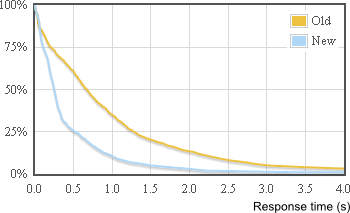Using LogParser to generate average response time graph
How can I get this graph:

(from Speeding up StackExchange)
It shows what percentage of web requests took longer than N seconds. I have IIS logs and LogParser installed but not sure how to proceed.
This is how you can do it with LogParser and Excel:
Step 1 Create the following query and save it as "Time taken graph.sql":
SELECT QUANTIZE(time-taken, 100) AS t, COUNT(*) as count
INTO 'Time-taken-graph.csv'
FROM u_ex*.log GROUP BY t
Step 2 Run the query and export results to CSV file:
LogParser.exe file:"Time taken graph.sql"
Step 3 Open CSV file in Excel. I will use Excel 2010 as example.
Let's say your data sits in A1:B401 range:

Put "Time" in D1 cell. Put "Percent" in E1 cell. Fill time in D column with series starting from 0 to 5 with step 0.1:

Step 4 Put the following formula into E2 cell (you will need to replace 401 with your value):
=SUMIF($A$2:$A$401,">="&D2*1000,$B$2:$B$401)/SUM($B$2:$B$401)

Copy the formula to all cells in E column that have corresponding time value. Set style to Percent by pressing Ctrl+Shift+%

Step 5 Finally, build line graph based on the data in D and C columns:

I wrote a python program to generate that graph using the logs generated by our load balancer and flot to draw the actual graph.
I went through a couple of iterations before I decided on that graph:
I started with a scatter plot (response time versus time of day) which is informative in it's own right, good for getting a good feel for the shape and variance of your traffic even if it's not particularly good for communication.
Then I tried a histogram, which wasn't particularly useful because of the high variance.
Finally I ended up with this which is based on a histogram, but is cumulative and inverted.
I'd post the code but it is so specific to what I was doing that it isn't going to help anybody. So here's an approximation of the core function:
def point(times, cutoff):
"""
times: sorted list of response times
0 <= cutoff < 1
"""
size = int(len(times) * cutoff)
return (times[cutoff], 1 - cutoff)
You then plot the (x, y) coordinates as cutoff ranges over [0,1[ using your favourite plotting library.